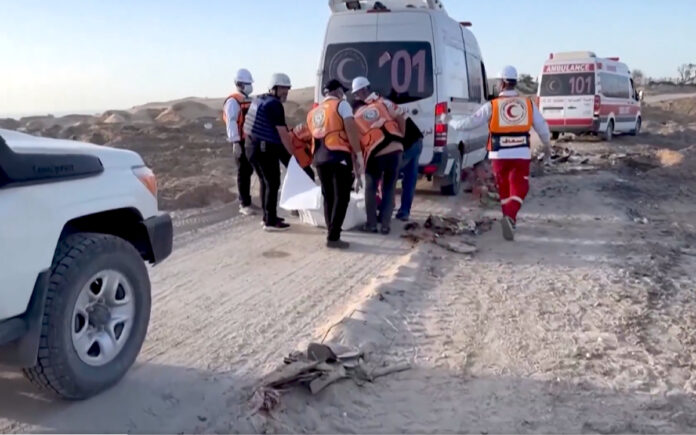Tel Aviv: The Israeli military has acknowledged multiple professional errors in connection with the March 23 killings of 15 emergency responders near Rafah in southern Gaza. Following a formal review, the military stated that one commander will be dismissed, while another will be formally reprimanded for misreporting the deadly incidents.
The shootings occurred in three separate incidents at the same location. Emergency workers from the Palestinian Red Crescent, Gaza’s Civil Emergency Service, and the United Nations were fired upon while responding to earlier Israeli airstrikes. Their bodies were later discovered in a shallow grave by international officials.
In a statement on Sunday, the Israeli military said: “The examination identified several professional failures, breaches of orders, and a failure to fully report the incident.” It noted that a deputy commander, who was also a reservist and the field commander during the incident, provided an incomplete and inaccurate report and would be relieved of duty.
According to the findings, the initial two shootings were based on what soldiers misperceived as imminent threats. The third incident, however, involved a direct breach of operational orders during combat conditions. The military’s advocate general has launched a separate investigation, which could result in criminal charges.
A video retrieved from the phone of one of the victims and released by the Palestinian Red Crescent appeared to show uniformed medics and clearly marked ambulances and fire trucks being fired upon, despite having their emergency lights on.
Major General Yoav Har-Even, who led the internal probe, told reporters that the special forces unit believed it had engaged a Hamas vehicle but had actually fired on an ambulance. Two individuals were killed instantly, while a third was detained and questioned on suspicion of links to Hamas. He was released the next day after further interrogation.
The Israeli military claims Hamas has historically exploited civilian infrastructure, including ambulances, to carry out operations. Nonetheless, it emphasized that troops are trained to distinguish between genuine emergency responders and militants.
Military spokesperson Effie Defrin described the area as a “complex combat zone” and confirmed that the event was a mistake rather than an intentional act. He said the unit reported the incident immediately and made no effort to conceal what had occurred.
General Har-Even provided a breakdown of casualties, saying two were killed in the first encounter, 12 in the second, and one more in the third. The deaths occurred within a short span as part of what is now described as a tragic misidentification in a volatile environment.
Red Crescent and UN officials have said 17 personnel were deployed to assist those injured in earlier airstrikes. Drone footage shown to journalists revealed around 20 Israeli soldiers opening fire from approximately 30 meters away at marked emergency vehicles.
The military claimed the field commander misidentified the individuals who exited the ambulances and fire truck due to “poor night visibility” and ordered the troops to shoot.
Munther Abed, a paramedic who survived the assault but was briefly detained, stated that soldiers targeted clearly marked emergency vehicles. As of the latest reports, another Palestinian emergency worker remains in Israeli custody, according to the Red Cross and Israeli authorities.
Also Read: GOP Senator Blasts Trump Over Wrongful Deportation of Abrego Garcia
The military later alleged, without supplying evidence, that six of the 15 emergency workers killed were “Hamas terrorists,” a claim Hamas strongly rejected.
Roughly 15 minutes after the incident with the emergency vehicles, the military also fired on a Palestinian UN vehicle, blaming it on “operational errors in breach of regulation.”
Also Read: Alito Condemns ‘Midnight’ Supreme Court Order on Venezuelan Deportations
The military stated that at dawn, the bodies were gathered and the area cleared to prevent further harm and facilitate civilian evacuation. It defended the removal of the bodies under the circumstances but admitted that crushing the ambulances was an operational error.
“In general, there was no attempt to conceal the event, which was discussed with international organizations and the UN, including coordination for the removal of bodies,” the military concluded.



